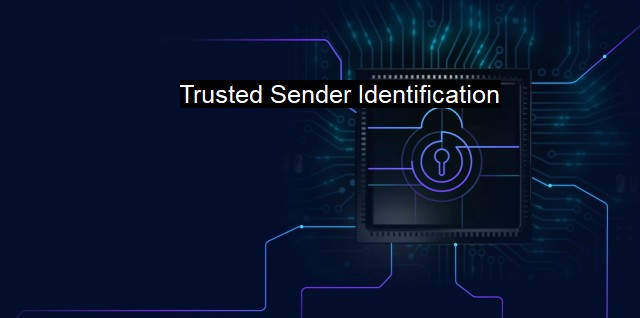What is Trusted Sender Identification?
Defending Against Email Spoofing: A Comprehensive Guide to Trusted Sender Identification
Understanding Trusted Sender Identification in the context of cybersecurity and antivirus is instrumental in mitigating threats and promoting online safety. In the face of continuously evolving cyber threats, various approaches and programs have been created to address phishing, malware, and other anomalies that compromise computer systems. One such proactive approach is Trusted Sender Identification.Trusted Sender Identification is a system involved in ensuring the trustworthiness and authenticity of the sender of an electronic communication, most commonly email. The system ensures that an email reaching a recipient's inbox is indeed from the source it claims to be, minimizing instances of 'spoofed' emails. Spoofing refers to falsifying the email sender's address to appear as if the email comes from a different, usually more trustworthy, source — a tactic often employed in phishing scams. By confirming the authenticity of sender's identity, Trusted Sender Identification contributes significantly to the general domain of cybersecurity and antivirus protection.
Applications of Trusted Sender Identification are diverse, from protecting individual devices to securing critical corporate networks. At its heart, the role of this system is validation. It examines the IP address of the sender against a set of criteria, checking if the source IP is authorized to send from that specific email domain. For instance, email authentication mechanisms like Sender Policy Framework (SPF), DomainKeys Identified Mail (DKIM), and Domain-based Message Authentication, Reporting & Conformance (DMARC) comprise components of Trusted Sender Identification. These approaches grant domain owners the ability to specify those IP addresses which are permitted to use their domain, thereby contributing to the prevention of email spoofing and phishing attacks.
Yet Trusted Sender Identification is not solely confined to email security. With the onset of more believers in, and users of, Internet of Things (IoT) and Industrial Control Systems (ICS), this concept is becoming increasingly important in these domains. These systems, which are typically employed without much thought given to in-depth security, are now getting smarter with the enhancement of antivirus measures and Trusted Sender Identification practices. This assists in identifying legitimate system-related commands, data, or files being sent to the system from authorized sources while negating potential cyber threats.
Critics often label Trusted Sender Identification as a tricky approach in the cybersecurity sphere because it operates based on the premise of total trust. The system assumes that an email from an authenticated domain is inherently trustworthy, potentially ignoring the possibility of an authorized domain being compromised. In such cases, malicious emails could slip through the cracks. it is essential to stress that Trusted Sender Identification is but one layer in a multi-layered approach to cybersecurity. It should function hand-in-hand with other protection mechanisms such as spam filtering, malicious link detection, and anomaly detection for effective cybersecurity and ensuring a strong 'defense in depth'.
Comprehensively, Trusted Sender Identification is an imperative cybersecurity mechanism that plays a crucial role in identifying and neutralizing potential cyber threats. With an efficiency to eliminate various forms of phishing and spoofing attacks at their roots, it provides a high level of security in digital communication. while it plays a vital role in securing systems and networks from such threats, Trusted Sender Identification should not be used as an exclusive measure for online safety. Its potency is realized when used with other robust protective systems and strategies that cover all aspects of cybersecurity and antivirus mechanisms. Therefore, leveraging Trusted Sender Identification in synergy with other cybersecurity practices can provide an enhanced defense mechanism in today's battle against cybersecurity threats.

Trusted Sender Identification FAQs
What is trusted sender identification?
Trusted sender identification is a cybersecurity process used to verify the authenticity and credibility of emails and their senders. It involves identifying whether an email is sent from a trustworthy source or a spammer, and it helps protect against phishing and other cyberattacks.How does trusted sender identification work?
Trusted sender identification works by using various techniques to verify the authenticity of the sender's email. It may involve checking sender reputation, analyzing email headers, and examining email content for signs of phishing or other malicious activity. The process typically uses antivirus software and advanced algorithms to determine whether the email is legitimate or not.Why is trusted sender identification important in antivirus software?
Trusted sender identification is important in antivirus software because it helps prevent users from opening or responding to malicious emails. Without this protection, cybercriminals can easily send out phishing emails or other scams, tricking users into divulging sensitive information, installing malware, or otherwise compromising their computers or networks.What are some common techniques used in trusted sender identification?
Some common techniques used in trusted sender identification include sender authentication protocols (SPF, DKIM, DMARC), sender reputation analysis, content filtering, email header analysis, and machine learning. These techniques work together to provide a comprehensive and reliable identification process that helps protect against a wide range of cyber threats.| | A | | | B | | | C | | | D | | | E | | | F | | | G | | | H | | | I | | | J | | | K | | | L | | | M | |
| | N | | | O | | | P | | | Q | | | R | | | S | | | T | | | U | | | V | | | W | | | X | | | Y | | | Z | |
| | 1 | | | 2 | | | 3 | | | 4 | | | 7 | | | 8 | | |||||||